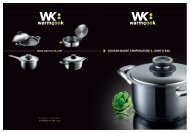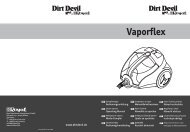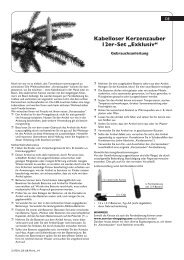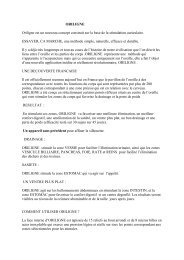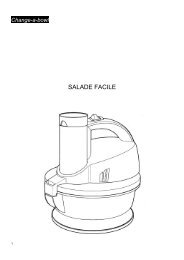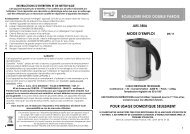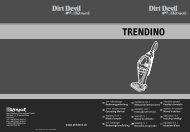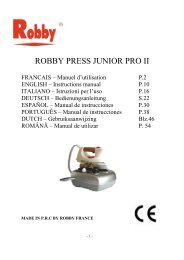Create successful ePaper yourself
Turn your PDF publications into a flip-book with our unique Google optimized e-Paper software.
OBJ_BUCH-1513-003.book Page 17 Monday, January 16, 2012 11:29 AM<br />
Declaration of Conformity<br />
We declare under our sole responsibility that the product described<br />
under “Technical Data” is in conformity with the following<br />
standards or standardization documents: EN 60335,<br />
EN 300 220-1:2006, EN 300 220-2:2007, EN 301 489-<br />
1:2008, EN 301 489-3:2002 according to the provisions of<br />
the directives 2011/65/EU, 2006/95/EC, 2004/108/EC,<br />
1999/5/EC.<br />
11<br />
Dr. Egbert Schneider<br />
Senior Vice President<br />
Engineering<br />
Robert Bosch GmbH, Power Tools Division<br />
D-70745 Leinfelden-Echterdingen<br />
Leinfelden, 26.09.2011<br />
Assembly<br />
Before any work on the machine itself, pull the mains<br />
plug.<br />
Unreel the Feed Hose (see figure A)<br />
– Open holding clamp 21 and completely unreel feed hose 2<br />
from base unit 5.<br />
– Lock holding clamp 21 again.<br />
Note: When painting only with the paint applicator 3 (without<br />
extension 1), the feed hose 2 can be fastened in one of the<br />
two exterior guide grooves 12 for more convenient working.<br />
Mounting the Extension (see figures B1 –B2)<br />
– Screw the screw connection 10 of the extension into the<br />
paint applicator 3.<br />
– Fasten feed hose 2 in the straight guide grooves 12 of<br />
paint applicator 3 and extension 1.<br />
– Remove remote control 8 from paint applicator 3 and clip<br />
it into holder 6 of extension 1.<br />
Operation<br />
Dr. Eckerhard Strötgen<br />
Engineering Director<br />
PT/ESI<br />
Before any work on the machine itself, pull the mains<br />
plug.<br />
Preparing for Operation<br />
Working close to the edge of open waters or on neighbouring<br />
areas in the direct vicinity of open waters is not<br />
permitted.<br />
When purchasing paint, observe its environmental compatibility.<br />
Preparing the Surface to be Painted<br />
The surface to be painted must be clean, dry and free of<br />
grease.<br />
When working indoors, all non-covered surface can be soiled.<br />
Therefore, thoroughly prepare the area around the surface to<br />
be painted:<br />
English | 17<br />
– Cover or mask off floors, furnishings, door and window<br />
frames, etc.<br />
– Also, sufficiently underlay the paint bucket and base unit<br />
with covering-off material (foil, cardboard, etc.).<br />
Preparing the Paint<br />
– Prepare the paint according to the manufacturer’s instructions.<br />
– Stir paint thoroughly and dilute as required.<br />
When the painting result is not satisfactory or no paint comes<br />
out: See “Correction of Malfunctions”, page 18.<br />
Coupling the Base Unit and the Paint Bucket<br />
(see figures C1–C2)<br />
– Set down base unit 5 level on the floor next to the opened<br />
paint bucket.<br />
– Pull the height-adjustable paint-bucket coupling 29 upward<br />
to the stop.<br />
– Hold the paint bucket handle upright and slide the hooks of<br />
the paint-bucket coupling down to the edge of the paint<br />
bucket.<br />
The paint bucket handle must always be positioned between<br />
the hooks of the paint-bucket coupling.<br />
– Insert the paint filter 22 to the bottom of the paint bucket.<br />
– Fasten the intake hose 4 in the holding clip 28.<br />
Starting Operation<br />
Observe correct mains voltage! The voltage of the power<br />
source must agree with the voltage specified on the<br />
nameplate of the machine. Power tools marked with<br />
230 V can also be operated with 220 V.<br />
Always place the base unit and the paint bucket on a<br />
level surface. When operating the paint roller on a ladder<br />
or an inclined surface, the base unit and the paint bucket<br />
can tip over or fall down. This can lead to injury and contamination<br />
from the coating material.<br />
Do not cover off the base unit. Otherwise, a possible malfunction<br />
cannot be detected.<br />
Keep other electrical machines/devices away while using<br />
the paint roller or cover them off adequately. Possibly<br />
occurring paint splashes can lead to accidents and soiling.<br />
Regularly provide for proper ventilation in the working<br />
range and for sufficient fresh air throughout the complete<br />
area.<br />
Wear safety glasses/goggles. This will protect your eyes<br />
against splashing or ejected paint.<br />
Wear appropriate work clothes. Paint is difficult to remove<br />
from clothing.<br />
Prevent the hose system from being constricted, e. g.,<br />
through crushing, kinking or pulling! Do not stand on the feed<br />
hose 2.<br />
Keep the hose system away from heat sources.<br />
Do not pull the hoses. Especially when moving the base unit,<br />
do not pull it by the feed hose 2. Carry the base unit only by<br />
the carrying handle 19.<br />
Bosch Power Tools 2 609 005 736 | (16.1.12)





